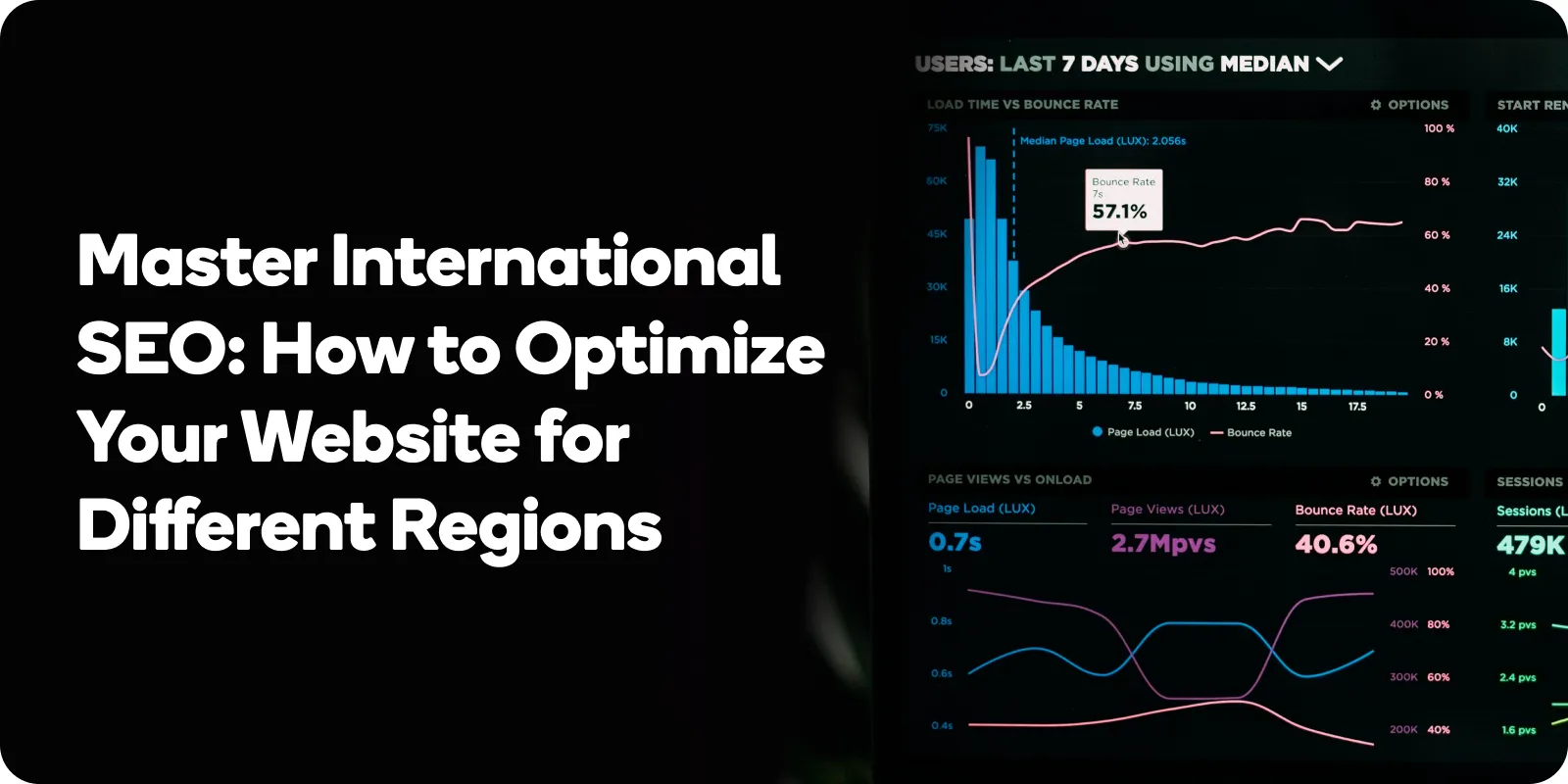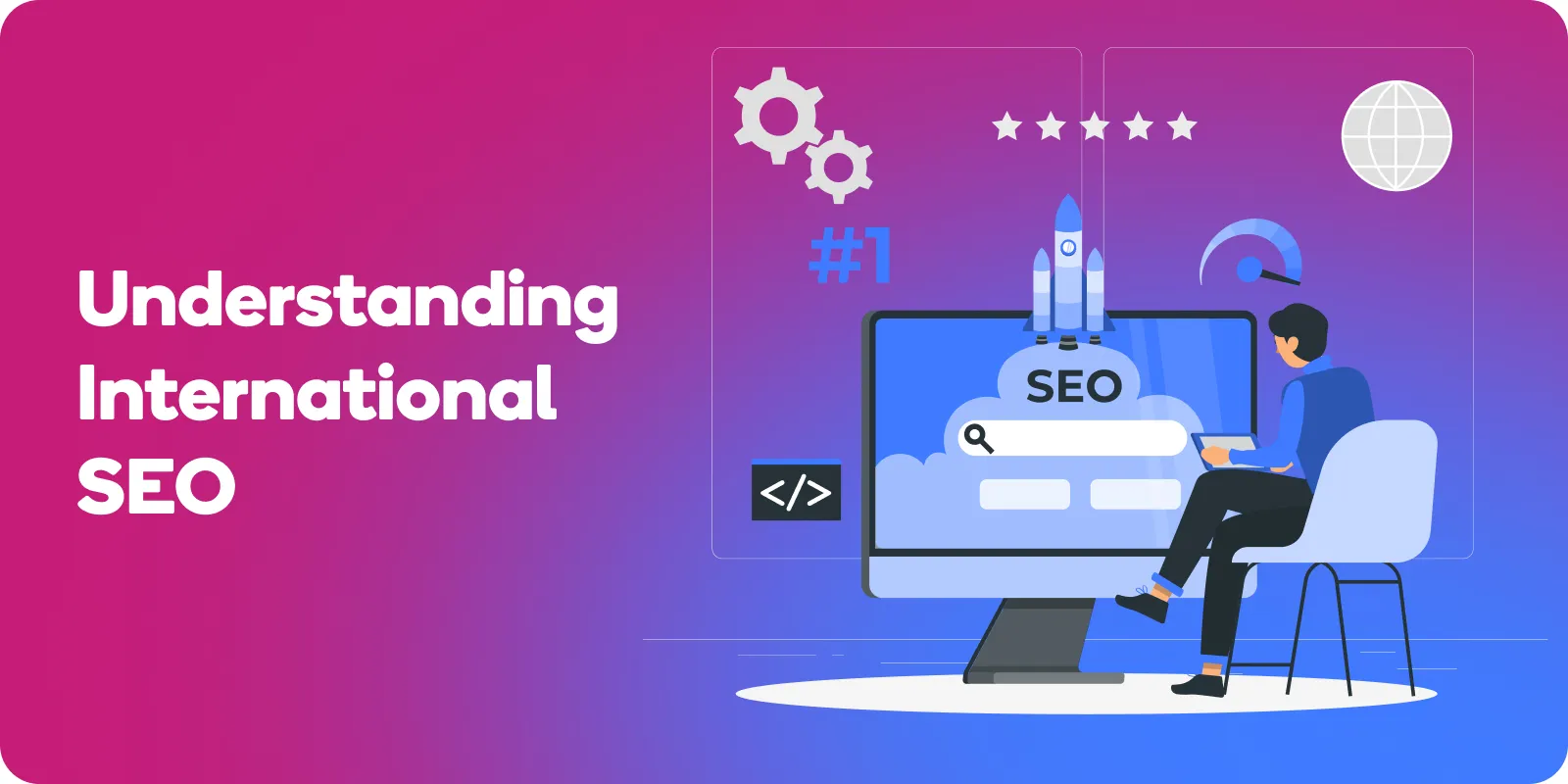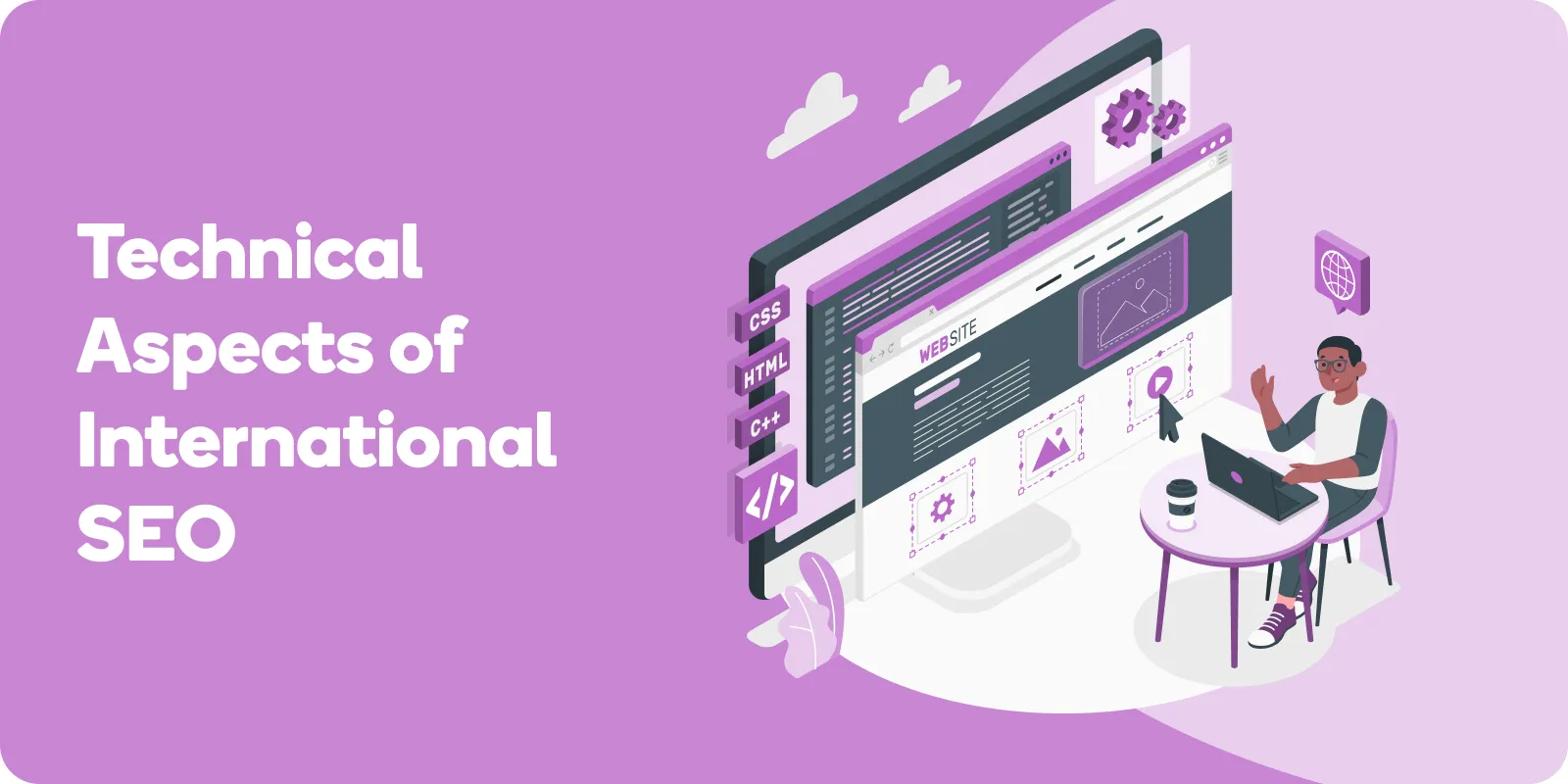In this blog post, we’ll guide you through the process of mastering international SEO, from understanding its importance to implementing effective strategies and measuring your success.
Understanding International SEO
International SEO refers to the practice of optimizing a website to rank in search engine results pages (SERPs) for various countries and languages.
This is essential for ensuring that your website is reachable from any region in the world, allowing you to tap into the potential of global markets and cater to a diverse audience.
But how does international SEO differ from local SEO? While local SEO focuses on optimizing a website to rank for a specific geographic region, international SEO targets multiple countries and languages, adapting the content and structure of your site accordingly.
To successfully implement an international SEO strategy, it’s crucial to conduct market analysis and conduct keyword research beforehand, taking into account the cultural context and language of your target audience.
This involves considering factors such as competitors’ rankings, search volumes for relevant keywords, and local search engine preferences.
Additionally, it’s important to ensure your website structure is optimized for international SEO, accommodating for different countries and languages through the use of ccTLDs, subdomains, or subdirectories.
The Role of International SEO
The primary purpose of international SEO is to increase the visibility of your brand to global audiences through strategic use of keywords.
This involves doing international keyword research and tailoring your approach to audiences located in multiple geographic areas, rather than focusing on a limited geographic region like local SEO.
By doing so, you can drive organic traffic from various countries and languages, expanding your reach and potential customer base.
On-page optimization, for instance, plays a significant role in international SEO, as it enhances the visibility of your brand to potential customers when they search for relevant keywords on other search engines too.
Additionally, it’s essential to communicate in the same language as your customers and answer questions within the relevant cultural context. This not only improves user experience, but also establishes trust and rapport with your target audience.
International vs. Local SEO
While international SEO aims to optimize your website for audiences in different countries, local SEO focuses on reaching local audiences within a specific city.
This involves targeting location-specific keywords, such as “online grocery store in NYC” or “buy vegetables online in Houston”.
To ensure your website ranks well for these location-specific keywords and targets every applicable city in the target country, you can create location-specific pages on your site.
Successful international SEO campaigns heavily rely on local SEO, as it’s necessary to rank for location-specific keywords and adapt your content to local cultures.
This involves obtaining feedback from native speakers of the target language to ensure your content is relevant and beneficial for the target local audience.
In a nutshell, international and local SEO work together to create a seamless and effective global marketing strategy.
Developing an Effective International SEO Strategy
To build a successful international SEO strategy, you’ll need to start with a thorough market analysis and competitor research. This involves identifying your target countries and languages, referring to your company’s global strategy to determine which markets to enter first.
Additionally, you’ll need to conduct international keyword research and consider whether creating a new website or subdirectory is necessary for each target country, based on the scope of your needs and the necessity for a potential new site or subfolder.
One of the crucial aspects of an effective international SEO strategy is adapting your content for different languages and cultures.
This involves not only translating your content, but also taking into account the cultural context of local language of your target audience.
By doing so, you’ll ensure that your website ranks well in search results for each target country, and your content resonates with users from different backgrounds.
Market Analysis and Targeting
The first step in initiating an international SEO strategy is identifying all the target countries where you intend for your products or services to appear in the organic search engine results pages.
This is essential, as the techniques used for SEO in one country may not be suitable for use in another.
A country-by-country strategy can be employed, which involves creating individual country-specific websites optimized for their country targeting respective international markets.
Market research is indispensable for international SEO. By conducting accurate research and listing your target countries, you can ensure that no target markets are overlooked, and you’re reaching the right audience with your content.
This will not only help you better understand your target markets, but also allow you to tailor your SEO efforts accordingly, increasing the chances of success.
Language and Cultural Adaptation
Adapting your content to cater to different languages and cultures is a crucial aspect of international SEO.
By tailoring your content to meet the needs and expectations of users from different backgrounds, you can ensure that your website is in line with local preferences and resonates with your target audience.
However, it’s important to avoid using machine translations, as they can be imprecise and negatively impact user experience, as well as generate duplicate content issues.
A language-based segmentation approach can be employed in international SEO, which involves optimizing content on your website so that it’s consistent across all applicable languages.
This can be achieved by including designated pages in each language spoken in your target countries. By doing so, you’ll ensure that your content is not only relevant but also accessible to users from different linguistic backgrounds.
Website Structure Options for International SEO
When implementing international SEO, it’s important to choose the right website structure that accommodates both your target countries and languages.
There are three primary website structure options for international SEO: ccTLDs, subdomains, and subdirectories. Each option has its own set of advantages and drawbacks, which should be carefully considered based on your specific needs and goals.
By understanding and evaluating the different website structure options, you can make an informed decision on which approach best suits your international SEO efforts.
This will not only help optimize your website for search engines, but also ensure a seamless user experience for visitors from different countries and languages.
ccTLDs
Country code top-level domains (ccTLDs) are an option for structuring websites. These are assigned to each country.
They provide a reliable means of informing search engines that a website is targeting users in a particular country. For instance, a website with a.ca ccTLD would be targeting users in Canada.
Utilizing ccTLDs can demonstrate a clear international presence, be straightforward to configure, and be tailored to a specific geographic area.
However, using ccTLDs may come with some drawbacks, such as diminished overall traffic, as many users favor sites that incorporate their country code TLD.
Additionally, it’s important to engage native-speaking experts when selecting domains for international SEO, as this can help ensure that the domain name chosen is not misinterpreted and does not cause embarrassment or mistrust.
Subdomains
Subdomains are another website structure option for international SEO, which involves creating distinct sections of a website, each with its own content and URL structure.
They can help organize and facilitate navigation to different areas of your website, acting as an extension of your domain name to create a well-structured directory for a particular purpose.
Subdomains provide the benefit of a country code top-level domain, as well as the advantages of a generic top-level domain.
However, there are some drawbacks to using subdomains for international SEO. Managing and maintaining subdomains can be challenging and can result in duplicate content issues if not properly managed.
Additionally, setting up and maintaining subdomains can be more costly than other website structure options, such as subdirectories.
Subdirectories
Subdirectories are directories contained within a parent directory and are utilized to organize files and other subdirectories in a hierarchical file system. In the context of a website, subdirectories are part of the website hierarchy under a root domain, with folders utilized to organize content.
Subdirectories offer the advantages of being cost-effective and easy to implement for international SEO.
However, using subdirectories may not be as effective in targeting particular countries compared to ccTLDs or subdomains.
Despite this, subdirectories can still be an effective website structure option for businesses looking to reach customers in a single market with multiple languages being used.

Award-Winning
Sales Funnel & Website Expert
Discover How My Agency Can Grow Your Business
- Website: Our websites are the perfect blend of form and function.
- Sales Funnel: We build sales funnels that turn leads into customers.
- SEO: Get found online with our expert SEO services.
Technical Aspects of International SEO
There are a range of technical aspects to consider when implementing international SEO. Some of these include country and language targeting, the use of hreflang tags, meta content language tags, and schema markup.
By understanding and employing these technical signals, you can optimize your website for search engines in different countries and languages, ensuring better visibility and reach for your target audience.
In this section, we’ll delve deeper into these technical components, discussing their purpose and usage in international SEO.
By mastering these technical aspects, you’ll be better equipped to navigate the complexities of international SEO and ensure your website is optimized for various regions and languages.
Implementing Hreflang Tags
Hreflang tags are a crucial component of international SEO, as they inform search engines which language is employed on a given page, allowing them to serve the appropriate language or regional URL in search results.
These tags can help resolve duplicate content issues by explicitly indicating the presence of alternative pages on the domain. Although meta content language tags are used to indicate the language of the content, they are significantly less powerful than hreflang tags.
To implement hreflang tags, you’ll need to include them in the head section of your HTML code, specifying the language and country codes for each version of your website’s content.
This will ensure that search engines understand the language and intended audience of each page, resulting in improved visibility and user experience for your international audience.
Meta Content Language Tags
Meta content language tags are HTML tags that indicate the language of the content on a webpage. They are used to specify the natural language of the content, not the coding language.
In international SEO, meta content language tags play a role in communicating the native language of of your website’s content to search engines, helping them understand and present your content accurately in search results.
Although meta content language tags are not as powerful as hreflang tags in international SEO, they still serve a valuable purpose in ensuring that your content is accessible and comprehensible to users from different linguistic backgrounds.
By including these tags in your website’s HTML code, you’ll not only improve your site’s search engine optimization, but also create a better user experience for your international audience.
Schema Markup
Schema markup is a structured data vocabulary that enables search engines to better comprehend the content on a webpage.
It is a standardized vocabulary utilized by search engines to categorize and label information on the internet, thus improving website optimization and visibility in organic search.
By implementing schema markup, you can support search engines in understanding the context of your content, likely resulting in more relevant search results.
Additionally, schema markup can facilitate the enhancement of local search results display by providing additional information concerning a business or location, such as address, phone number, hours of operation, and other pertinent information.
By incorporating schema markup on your website, you can improve search engine understanding and local search results appearance, ultimately boosting your website’s visibility and reach in different countries and languages.
Geo-Targeting and Local Listings
Geo-targeting is an essential aspect of international SEO, as it assists search engines in recognizing which countries or regions a website is aiming for. By setting up geo-targeting in tools like Google Search Console and Bing Webmaster Tools, you can ensure that your website is optimized for your target audience in each specific country or region.
Additionally, local listings, such as Google Business Listing and Bing Places, play a crucial role in managing your business locations for better search engine optimization.
In this section, we’ll discuss the importance of geo-targeting and local listings in international SEO, and how to set them up effectively.
By mastering these aspects, you’ll be able to improve your website’s visibility and reach across different countries and languages, ensuring that your content is accessible and relevant to your target audience.
Using Search Console for Geo-Targeting
Setting up geo-targeting in Google Search Console and Bing Webmaster Tools is a crucial step in optimizing your website for international SEO.
By accessing the International Targeting report in Google Search Console and the Settings tab in Bing Webmaster Tools, you can select the desired country or region you want to target, as well as specify the language you wish to target.
By configuring geo-targeting for your website, you’ll help search engines understand which countries or regions your content is intended for.
This will not only improve your website’s visibility in search results for those specific countries or areas, but also ensure that your content is more relevant and accessible to users from different countries and languages.
Google Business Listings and Bing Places
Google Business Listings and Bing Places are free tools that enable businesses to manage their online presence on Google and Bing, respectively.
By utilizing these tools, businesses can create and manage their business profiles, respond to reviews, publish posts, and answer questions, allowing them to connect with customers and reach more people on Google and Bing Search and Maps.
Setting up and managing your business locations in Google Business Listing and Bing Places is essential for local SEO, as it helps improve your website’s visibility in search results for specific regions or countries.
By keeping your business information up-to-date and accurate, you’ll ensure that users can easily find and engage with your business online, ultimately boosting your international SEO efforts.
International Link Building Strategies
Link building is an essential aspect of international SEO, as it helps increase domain authority, promote international websites, and direct pertinent local referral traffic.
To construct links for international SEO, you’ll need to take into account cultural factors of the target market, create content that is both appealing and optimized, and abstain from duplicating existing strategies.
This involves developing a solid link-building strategy for each market, as local links will have the greatest impact on search results.
In this section, we’ll explore various link building strategies for international SEO, emphasizing the need for unique approaches for each target market.
By mastering these strategies, you’ll be able to effectively reach your target audience in different countries and languages, improving your website’s visibility and reach in the process.
Creating Optimized Content
Creating high-quality, optimized content is crucial for successful international SEO. This involves researching your target audience, tailoring your content to their needs and preferences, and optimizing your content for search engines.
Examples of optimized content include localized content, content tailored to specific keywords, and content adapted for mobile devices and voice search.
By producing optimized content for different regions, you’ll ensure that your website ranks well in search results for each target country, and your content resonates with users from different backgrounds.
This will not only improve your website’s visibility and reach, but also help you establish trust and rapport with your target audience.
Avoiding Duplicate Efforts
When constructing links for international SEO, it’s important to avoid replicating strategies of others, as this may result in a lack of creativity and an absence of comprehension of the regional and international market itself.
Instead, by creating a bespoke approach, you’ll gain a deeper understanding of the local market, language, and culture, allowing you to produce content that is specifically tailored to the local market, resulting in improved outcomes.
By developing a unique approach for each target market, you can distinguish your business from the competition and create a unique brand identity.
This will not only help you stand out in the crowded online marketplace, but also ensure that your international SEO efforts are more effective and successful.
Measuring the Success of Your International SEO Efforts
Monitoring and evaluating the effectiveness of your international SEO strategy is crucial to ensuring that your efforts are fruitful and that you are targeting the right audiences.
To track and analyze the performance of your international SEO efforts, you can use tools such as SEMrush and Ahrefs for monitoring international rankings, as well as Google Analytics for analyzing traffic and conversions from different countries.
In this section, we’ll discuss the various methods for tracking and analyzing the performance of your international SEO strategy, allowing you to make data-driven decisions and optimize your efforts for maximum success.
By regularly monitoring your international SEO performance, you’ll be able to identify areas for improvement, adjust your strategy accordingly, and ensure that you’re reaching your target audience in different countries and languages.
Tracking International Rankings
Monitoring international rankings is an essential aspect of measuring the success of your international SEO efforts.
Tools such as SEMrush and Ahrefs can be utilized for this purpose, providing valuable insights into your website’s performance in search results across different countries and languages.
By tracking your international rankings, you’ll be able to identify trends and areas for improvement, allowing you to optimize your strategy for maximum success.
In addition to SEMrush and Ahrefs, other tools like STAT and Authority Labs can be used to monitor international rankings and increases in traffic for specific keywords.
By regularly tracking your international rankings, you’ll gain a deeper understanding of your website’s performance in various regions, helping you make data-driven decisions and optimize your international SEO efforts.
Analyzing Traffic and Conversions
Analyzing traffic and conversions from different countries is another important aspect of measuring the success of your international SEO efforts.
Google Analytics is a powerful tool for this purpose, allowing you to monitor website traffic from different countries and evaluate the effectiveness of different marketing campaigns in those countries.
In addition to Google Analytics, other tools such as heat mapping tools, A/B testing tools, and user testing tools can be utilized to analyze traffic and conversions from different countries.
These tools can provide insight into areas that may need improvement and optimize the user experience for your target audience in different regions.
By regularly analyzing your traffic and conversions, you’ll be able to identify trends and opportunities for growth, ensuring the ongoing success of your local and international seo and SEO efforts.
Frequently Asked Questions
What is international SEO?
International SEO is the process of optimizing your website so that search engines can identify the countries you wish to target and the languages you use for business. This type of SEO is crucial for businesses operating in multiple countries or offering their content in different languages. It involves implementing various strategies and techniques to rank your website in different countries and in different languages.
This includes using hreflang tags for language targeting, having a country-specific domain or subdomain, creating content specific to the region you’re targeting, and complying with the local search engine norms and regulations.
How do I create an international SEO?
Creating an international SEO strategy involves several steps:
- Identify Your International Audience: Use analytics tools to identify the countries and languages of your existing audience. This will help you decide which countries to target.
- Research Keywords: Conduct keyword research for each target country. Remember that direct translations often don’t work; the way people search can vary by country and culture.
- Choose Your Web Structure: Decide on the most appropriate web structure. This might be a country-specific domain (ccTLD), a subdomain, a subdirectory, or URL parameters.
- Use Hreflang Tags: Use hreflang tags to tell search engines which language you’re using on a specific page, so they can serve that page to users who speak that language.
- Create and Optimize Content: Create high-quality content that meets the needs and interests of your international audience. Remember to optimize it with the right keywords.
- Localize Your Content: It’s not just about translation; localization involves adapting your content to include local expressions, references, and conventions.
- Build Local Links: Build links from websites in the countries you’re targeting. This will improve your site’s authority in those countries.
What is the difference between local SEO and international SEO?
Local SEO and international SEO are both strategies used to optimize websites for search engines, but they target different levels of geography.
Local SEO is focused on optimizing a website to be found in local search results. This is typically important for businesses that have a physical location or serve a specific geographic area. Strategies might include optimizing for local keywords (like “coffee shop in Los Angeles”), managing online reviews, and ensuring the business’s name, address, and phone number (NAP) are consistent across all online listings.
International SEO, on the other hand, is about optimizing your website for multiple countries and languages. This involves strategies like using hreflang tags for language targeting, having a country-specific domain or subdomain, and creating content specific to each region you’re targeting.
How much is international SEO?
The cost of international SEO can vary widely depending on the complexity of the project, the number of countries and languages you’re targeting, the current state of your website, and the agency or professional you choose to work with.
Some SEO agencies might charge an hourly rate, which can range from $50 to $200 per hour or more. Others might charge a monthly retainer, which could range from a few hundred dollars to several thousand dollars per month.
Remember that international SEO is a significant investment that involves not just translation, but also localization of content, keyword research for each target market, technical SEO setup for each language version of your site, and building local links. All of these tasks require a significant amount of time and expertise, which is reflected in the cost.
Conclusion
In conclusion, international SEO is a powerful tool for businesses looking to expand their reach and tap into global markets.
By understanding the intricacies of international SEO, from website structure options to technical aspects and link building strategies, you’ll be better equipped to optimize your website for different countries and languages.
With the right approach, you can reach your target audience in various regions, ensuring your content resonates with users from different backgrounds.
As you embark on your international SEO journey, remember to measure your success through tracking and analyzing your efforts, allowing you to make data-driven decisions and optimize your strategy for maximum success.












